| "The Battlefield of Iwo: An Ugly Island Becomes a Memorial to American Valor" An Article from Life Magazine, April 9, 1945 |

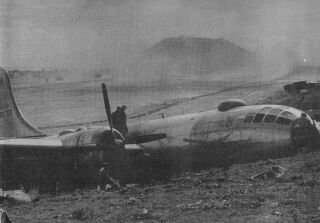
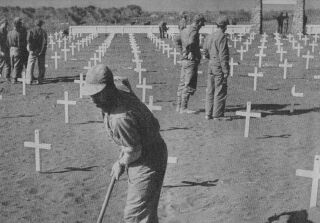
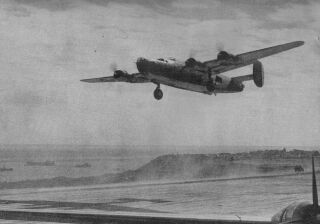
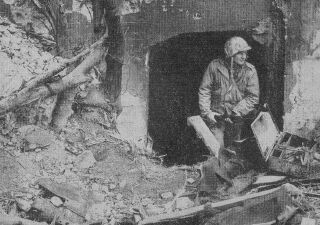
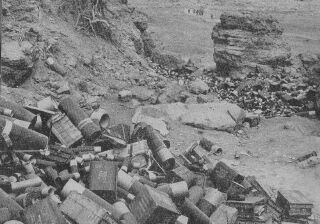
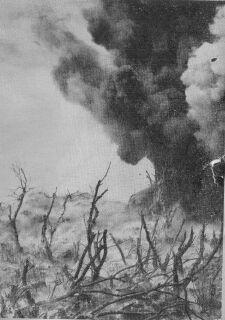
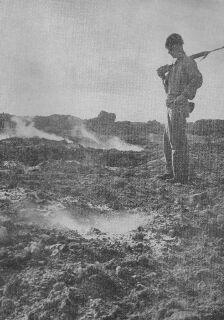
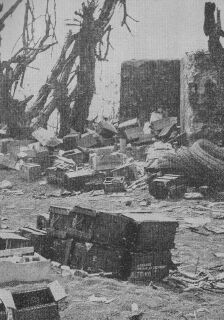
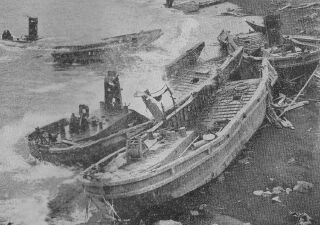
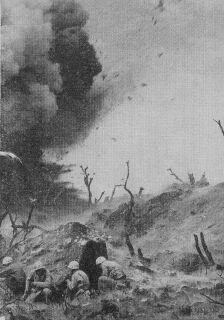
| The bloody victory on Iwo Jima came too late to save many lives from the 73rd Bombardment Wing Fliers, but it saved the lives of thousands of men who came after them. * Article and photo descriptions are as they appear in the original article in Life magazine, including negative stereotypes common to the era. |
| "Marines blow up cave, man at right has just leaned on plunger. Here, on the eastern side of the island, there had been a patch of banyan jungle before bombardment." |
| "Hill 382 held the Japs' left flank firm for five bloody days and raked the whole American position. Now its summit is litter with shattered banyan trees and Marine ammunition cases. Jap defense was skillful, it avoided fruitless suicide charges. Marines found few dead Japanese; they were either buried or had been pulled back." |
| "Headquarters on Hill 382 was probably this three-tiered blockhouse with five-foot walls. Tank finally opened a hole. Satchel charge enlarged it and flame-throwing tank polished it off." |
| " 'Meat Grinder Hill' looms above amphitheater. Across here Marines charged again and again. This was highest hill on northern end. Dark spots are cave entrances, concealing death." |
| "A B-29 superfortress shot up in a night raid on Tokyo lies on Iwo's airfield where it made emergency landing. Here it will be repaired for the 725 mile trip to Saipan." |
| "The B-24 in the air is one of many that dropped supplies during battle." |
| "Boat basin at end of beachhead shows damage inflicted on Japanese craft by bombing. In background is part of invasion armada." |
| "Sulphur Springs boiled intermittently under 3rd Division, holding the center. Marines heated rations on them. Whole island sputtered, chasing Japanese out of caves too hot for them." |
"5th Division Cemetery is where a good many of the
division died. The Marines here are reading the
names of friends. In one of these graves lies
Gunnery Sgt. John Basilone, killed after knocking out
five blockhouses in charge up beach toward first
airfield. The 5th Division took its punishment around
the volcano and along western shore of the island."
division died. The Marines here are reading the
names of friends. In one of these graves lies
Gunnery Sgt. John Basilone, killed after knocking out
five blockhouses in charge up beach toward first
airfield. The 5th Division took its punishment around
the volcano and along western shore of the island."
Frightful as was the price of Iwo Jima, it took the war a very long way toward Japan. The Marines who
bled there gave their country a strong sword against the enemy and saved the lives of many times their
number of other Americans. On Iwo great bombers will refuel and take off for the bombardment of the
farthest reaches of Japan. Fleets of fighters will rise to protect the bombers, to support American fleet
actions and amphibious landings in the East China Sea and to patrol and reconnoiter there.
The capture of Iwo brought two immediate benefits. It wiped out a critical Jap radar outpost which had
been warning Japan of the approaching U.S. bombers. And by last week, more than 50 B-29's on their
way home from Japan had put in at Iwo's airfield. But for Iwo, they would have ditched in the ocean.
Those 50 mean 500 American men and $30,000,000 in weapons. The Marines bought and paid for
those men and weapons.
Iwo had thus become the newest of that far-flung, strangely assorted collection of U.S. air bases from
Baffinland to Ascension Island, to the Persian Gulf and China.
After the war the tortured battleground of Iwo may not be an appealing tourist attraction. But for
Americans it will always have undying majesty. Here American men walked steadily into their graves for
a cause that they would not agree to abandon.
bled there gave their country a strong sword against the enemy and saved the lives of many times their
number of other Americans. On Iwo great bombers will refuel and take off for the bombardment of the
farthest reaches of Japan. Fleets of fighters will rise to protect the bombers, to support American fleet
actions and amphibious landings in the East China Sea and to patrol and reconnoiter there.
The capture of Iwo brought two immediate benefits. It wiped out a critical Jap radar outpost which had
been warning Japan of the approaching U.S. bombers. And by last week, more than 50 B-29's on their
way home from Japan had put in at Iwo's airfield. But for Iwo, they would have ditched in the ocean.
Those 50 mean 500 American men and $30,000,000 in weapons. The Marines bought and paid for
those men and weapons.
Iwo had thus become the newest of that far-flung, strangely assorted collection of U.S. air bases from
Baffinland to Ascension Island, to the Persian Gulf and China.
After the war the tortured battleground of Iwo may not be an appealing tourist attraction. But for
Americans it will always have undying majesty. Here American men walked steadily into their graves for
a cause that they would not agree to abandon.